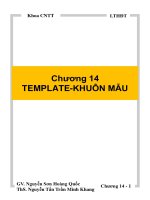Ppt Mẫu.ppt
Bạn đang xem bản rút gọn của tài liệu. Xem và tải ngay bản đầy đủ của tài liệu tại đây (490.53 KB, 11 trang )
DISSERTATION DEFENSE
On the Innovation Design of Novel
Transmission Systems for Electrified Vehicles
電動車輛新型傳動系統之設計
Reasons the electrified vehicle market is growing
Hybrid Vehicle
Fuel economy
Reduce
Emissions
Reduce
Structures
Electric Vehicle
Lower
battery costs
Reporter : Hoang Ngoc Tan ( 黃玉新 )
Advisor : Prof. Hong-Sen Yan
Date
: 2019.01.25
1
More charging
stations
Consumer
acceptance
OUTLINE
Literature Review
Chapter 1: Introduction
Design Specifications
Chapter 2: Literature Review
Patent Search
Classification of Hybrid Systems
Synthesis of feasible PGTs
Chapter 3: Synthesis of feasible PGTs
Configuration Synthesis
Chapter 4: Synthesis of HTs
Synthesis of HTs
Synthesis of MTs
Atlas of feasible PGTs
Chapter 5: Synthesis of MTs
New Transmission Systems
Atlas of Hybrid Transmissions
Atlas of Motor Transmissions
Chapter 6: Design of the new TSs
Kinematic Analysis
System Analysis
Chapter 7: Simulation of the new TSs
Power Flow Analysis
Efficiency Analysis
Chapter 8: Conclusions and Suggestions
2
Modeling
System Simulation
Energy Management Strategy
ORGANIZATION OF DISSERTATION
I. Introduction
1.1 Motivations
V. Synthesis of MTs
1.2 Objectives
5.1 Motor Transmissions with The
Simple PGT
1.3 Dissertation Contributions
1.4 Organization of Dissertation
5.2 Motor Transmissions with The
Compound PGTs
II. Literature Review
2.1 Historical Development
5.3 Novel Motor Transmissions
2.2 Architectures of HEVs
5.4 Summary
2.3 Architectures of EVs
2.4 Methodology
IV. Synthesis of HTs
III. Synthesis of feasible PGTs
4.1 Hybrid Transmissions with
The Simple PGT
4.2 Hybrid Transmissions with
The Compound PGTs
3.2 The Simple PGT
4.3 Novel Hybrid Transmissions
3.3 The Double Planet PGT
3.4 The Compound PGTs
P1
P2
6.1 Teeth Number Constraints
6.2 Design Vehicle Specifications
6.3 Teeth Number Design
6.4 Kinematic and Dynamic
Analysis
6.5 Summary
P3
2.5 Summary
3.1 Synthesis Process
VI. Design of the new TSs
VII. Simulation of the new TSs
7.1 Simulation Model
7.2 Control Logic
7.3 Optimization
7.4 Simulation Results
P4
7.5 Summary
4.4 Summary
VIII. Conclusions and Suggestions
3.5 Summary
3
ORGANIZATION OF DISSERTATION
4
ORGANIZATION OF DISSERTATION
5
ORGANIZATION OF DISSERTATION
6
ORGANIZATION OF DISSERTATION
7
VITA
Name
: Ngoc-Tan Hoang ( 黃玉新 )
Date of birth
: November 17, 1985
Place of birth
: Bien Hoa-Dong Nai, Vietnam
Educations
:
Experiences
National Cheng Kung University
PhD degree
National Ho Chi Minh University of Technology
Master degree
Ho Chi Minh University of Technology and Education
Bachelor degree
9/104 ~ 1/108
Ho Chi Minh of Industrial University – Vietnam
Lecturer
Honda Automobile – Dong Nai – Vietnam
Technical Consultant
Mitsuba Technical Center of HCMC – Vietnam
Design Staff
9/101~9/104
9/97 ~ 6/99
9/92 ~ 1/97
:
8
6/99~9/101
8/97~6/99
RESULTS & CONTRIBUTIONS
1. Existing Designs
Enumeration
1. Results
Diagram Conversions
2. Replacement Diagrams
Number Synthesis
Topological Characteristics
4 SCI Journal Papers
3. Generalized Kinematic Chains
Specilization
Design Constraints
4. Feasible Specialized Chains
Particularization
5. Atlas of Mechanism Designs
Power Arrangement
Power Constraints
6. Atlas of Clutchless Transmissions
Clutch/Brake Arrangement
Basic Operation Modes
7. Atlas of Clutched Transmissions
Existing Designs
2. Contributions
8. Atlas of Novel Transmissions
System Specifications
Gear Constraints
9. Gear Teeth Number Design
A Systematic Design
(Explained in Chapter 4)
Process
Dynamic Analysis
Shifting Analysis
10. System Analysis
Simulation Structure
Detail Systems
11. Modeling
Atlas of Feasible PGTs, HTs, MTs
(Appendix A, B, C, D, E, F, G, H, I)
Control Parameters
Optimization
12. Control Logic
Driving Cycles
Energy Management Strategy
13. Simulation Results
A Simulation Process
Evaluation
14. Atlas of The Best Transmissions
9
INTRODUCTION
Motivation
Energy
source
Renewable energy
Hydropower
Fossil fuel
Biofuel
Ethanol
Coal
Wind
Biodiesel
Biomass
Natural gas
…...
Solar
Geothermal
On-board
energy
Electrical energy
Nuclear
Hydrogen
Electrified Vehicle
PEV
FCEV
Propulsion
system
ER-EV
Micro-HEV
Mild-HEV
PHEV
Figure 1.1
Petrolumn
Strong-HEV
Liquification
CNG
Convention vehicle
Flexible-fuel vehicle
Hybrid vehicle
HV with battery
HV with flywheel
HV with air tank
…...
Alternative fuel and powertrain solutions [3]
10
THANK YOU FOR YOUR ATTENTION! Q & A
On the Innovation Design of Novel
Transmission Systems for Electrified Vehicles
電動車輛新型傳動系統之設計
Reasons the electrified vehicle market is growing
Hybrid Vehicle
Fuel economy
Reduce
Emissions
Reduce
Structures
Electric Vehicle
Lower
battery costs
Reporter : Hoang Ngoc Tan ( 黃玉新 )
Advisor : Prof. Hong-Sen Yan
Date
: 2019.01.25
11
More charging
stations
Consumer
acceptance









